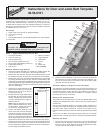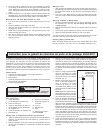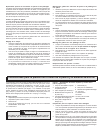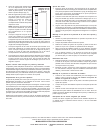
Instructions for Door and Jamb Butt Template
49-54-0101
The MILWAUKEE Door and Jamb Butt Template is for use with a router
equipped with a templet guide to cut mortises for hinges on 1-3/4", 2",
and 2-1/4" thick doors that are 6'6", 6'8" and 7' long. It can also be used
on jambs with or without a door stop installed. Mortises for 1-3/8" doors
can also be cut provided the door stop has not been installed. Hinge size
is adjustable from 2-1/2" to 5-1/2".
Kit includes:
1 Upper frame housing (with top gauge assembly)
2 Lower frame housing
2 Link rail
1 5/8" Template guide for use with MILWAUKEE 49-54-1040 subbase.
12 Extra nails
8. Position the third assembly so the arrow on the side rail faces the
same direction as the first assembly. Place the third assembly onto
the link rail. Secure the link lock screw at the same Hinge Length
used with the second assembly.
Uncommon Spacing of Hinges on Doors and Jambs
The template is physically adaptable to uncommon hinge spacings, but
the markings on the link rails will not necessarily apply. Follow the same
procedures as above, except mark the hinge locations on the edge of
the door and adjust the frame and rail sections to correspond. Always
work down from the top of the door.
Attaching the Template Guide
The included router template guide is for use with MILWAUKEE routers
equipped with subbase 49-54-1040. Other routers may require different
accessories.
Use the correct template guide for your hinges. When mortising for a
rounded corner hinge, the mortising bit, template guide and hinge corner
radii must match. When mortising for a square corner hinge, use the
smallest radius mortise bit to leave the minimum material to be chiselled
out.
Unplug the tool. Attach the template guide according to the template
guide instructions and the instructions in the Router Operator's Manual.
Adjusting the Router
1. Insert the bit according to the instructions in your Router Operator's
Manual. However, DO NOT insert the bit all the way into the collet.
Insert only 1/2" of the bit shank before properly tightening the collet.
You will need the extra length for mortising.
13
12
10
11
1
2
3
4
5
6
7
8
9
Fig. 1
2
W ARNING!
To reduce the risk of injury, read and understand the
operator's manual packaged with your power tool.
Setup for Common Hinge Spacing
1. Place the hinge butt template on a workbench or suitable surface. Be
sure the arrows on the side rails (7) face the same direction.
2. Measure the door thickness. Insert the door thickness screws (4) into
the threaded hole that corresponds to the measured door thickness.
3. Measure the hinge to be used. Adjust each assembly for hinge length
by inserting the hinge length pin (9) in the hole corresponding to the
measured hinge. Place the hinge between the hinge length pin and the
hinge length guide (6). Adjust the hinge length guide until it touches the
hinge and tighten the two screws (5). Remove the hinge. Repeat with
other two assemblies.
4. Adjust the top gauge assembly in the
upper frame housing for the desired
distance from the top of the door to
the first hinge (Fig. 2).
5. Measure the door length. Place one of
the link rails (11) into the upper frame
housing and tighten the link lock screw
(2) at the appropriate door height im-
printed on the rail.
NOTE: Align the markings on the rails
with the "READ HERE" arrow (10) on
the assemblies. Tighten the link lock
screw into the appropriate hole.
6. Position the second assembly so the
arrow on the side rail faces the same
direction as the first assembly. Place
the second assembly onto the link rail.
Read the nameplate and determine
5"
Equal Equal
10" *
Fig. 2
Standard
Location of
Hinges on Doors
Figure 1 - Upper Frame Housing and Link Rail
1. Top gauge assembly
2. Link lock screw (2*)
3. Spring loaded nail (4*)
4. Door thickness gauge/screw (2*)
5. Hinge length guide adjusting screws (4*)
6. Hinge length guide (2*)
7. Side rail (2*)
8. Area for mortising
9. Hinge length pin
10. "Read Here"
11. Link rail
12. Door
13. Router area
* per assembly
which Hinge Length Scale to use on the link rail according to the door
height. Secure the link lock screw at the appropriate hinge length.
7. Position the second link rail so the arrows on the nameplate face the
same direction as the first link rail. Place the second link rail into the
second assembly and tighten the link lock screw (2) at the appropri-
ate door height imprinted on the rail.






